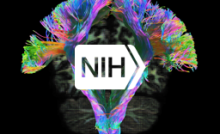
Post-doctoral fellow, Dr. Justin O’Hare, and colleagues publish landmark paper in Science, finding for the first time that intracellular calcium release plays a key role in how the brain adapts to new environments.
As a tourist, you might need directions to go from a hotel to a restaurant, but spend a few days in that town, and the task of navigating from the hotel to the restaurant becomes trivial. How our brains learn, remember, and navigate new environments has been an enduring mystery in neuroscience.
Neurons in the brain talk to each other via connections known as synapses. Networks of neurons within a region of the brain called the hippocampus form and retain memories by strengthening these connections. A groundbreaking study, highlighted recently by acting NIH Director Dr. Lawrence Tabak and led by an NIH BRAIN Initiative F32 awardee, points to an underappreciated mechanism for how synaptic connections become stronger in the brain and help mice better remember where they are.
Calcium, a key signal that drives changes in synaptic strength, is kept at very low concentrations inside neurons at rest. Previous research has implicated the rush of calcium into a neuron from its surroundings as the major driver of changes in synaptic strength. This new study revealed that the release of calcium from a reservoir called the endoplasmic reticulum, located inside a neuron, also plays a critical role in mice remembering their way when navigating new routes. This work, led by Dr. Justin O’Hare and his colleagues at Columbia University, discovered this phenomenon by employing several cutting edge neurotechnologies that include sophisticated microscopy, manipulating and imaging of neural activity, and genetic tricks that increased the release of calcium internally in neurons in mice navigating a virtual maze.
As mice explore a new environment, distinct neurons located in the hippocampus, a key structure involved in learning and memory, are activated at specific locations in the environment. This can be studied using genetically encoded calcium probes allowing neurons to emit fluorescence when they are active, and this activity can be monitored in mice exploring their environment as shown in this video. With repeated exploration of the same environment, mice remember unique aspects of the environment, and the same neurons in the mouse hippocampus are activated at the same location. To test the role of internal calcium release for remembering a location in the environment, Dr. O’Hare and his colleagues used genetically modified mice where the internal release of calcium is increased in individual hippocampal neurons. These neurons with artificially augmented internal calcium release more reliably ‘remembered’ when to be active in the environment, and encoded a larger area of the environment, thus providing concrete evidence for the role of this mechanism in helping mice remember where they are. Investigations such as these help researchers decipher how other animals, including humans, navigate their environment, and raises the possibility that humans rely on the same neural mechanisms to build representations of their world.
Dr. O’Hare received a BRAIN Initiative F32 Individual Postdoctoral Fellowship award to help support the study, which was also partially supported by a U19 Team-Research BRAIN Circuit Program award. The BRAIN funding portfolio enables the collaborative and multidisciplinary approaches necessary to solve the complexity of the brain. Both funding opportunities are currently accepting applications. The next deadline to apply for an F32 fellowship is December 9, 2022.
More information about the study, including a graphical abstract, is available from Science. A preprint version is available on bioRxiv. Stay tuned for more highlights from the BRAIN Initiative award recipients in some exciting, upcoming series on the BRAIN Blog.
